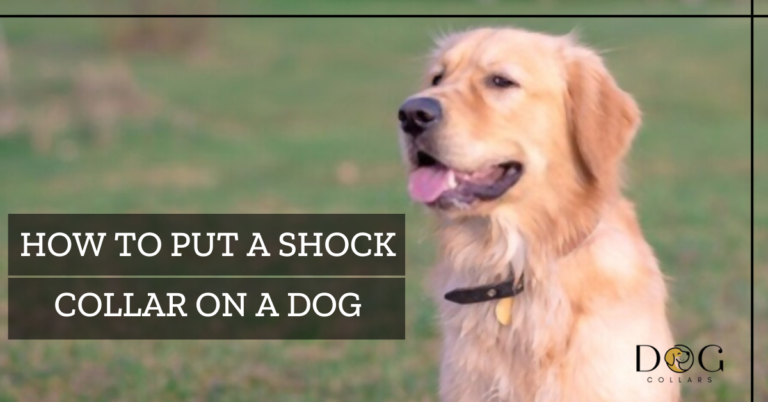Do Dogs Feel Shock Collars -Separating Fact From Fiction

Imagine a small electric jolt coursing through your neck, catching you by surprise each time you misstep. That unsettling sensation is precisely what dogs may experience when fitted with shock collars.
Yes, dogs can feel shock collars. E-collars are designed to deliver electrical stimuli or shocks to a dog’s neck when triggered by a remote control or an automatic mechanism. These shocks are meant to deter unwanted behaviors but also help to get your dog attention.
In this exploration, we delve into the mechanisms do dogs feel shock collars and their potential impact on dogs, shedding light on the real experiences of our canine companions when subjected to this controversial training method.
How Shock Collars Work
These e-collars also known as electronic collars or e-collars, are training devices that deliver an electronic pulse or static stimulation to the dog when triggered. These collars come with a remote control that allows the handler to administer the shock. When another dog is barking it also triggers the collar for your doogo.
The Purpose of Shock Collars
Shock collars or vibration collars are designed for various training purposes, including obedience training and behavior modification. They are commonly used to deter undesirable behaviors such as excessive barking, aggression, or disobedience.
Do Dogs Feel Shock Collars- The Sensory Perception Of Dogs
Dogs, like humans, have a complex sensory system that allows them to perceive and respond to various stimuli in their environment. Understanding how dogs perceive the sensation produced by bark collars is essential in assessing whether these devices cause discomfort or pain.
Understanding a Dog’s Sensory Perception
To comprehend whether dogs feel shock collars, it’s crucial to delve into their sensory perception. Dogs have a heightened sense of touch compared to humans. Their skin is more sensitive, which makes them capable of perceiving even subtle sensations.
The Reaction to Shock
When a shock is administered through a collar, dogs react differently based on their temperament and pain threshold. Some may yelp, while others may exhibit signs of discomfort, confusion, or fear. However, it’s essential to note that the sensation is uncomfortable but not necessarily painful.
The Debate: Discomfort vs. Pain
Evaluating Discomfort
The sensation produced by shock collars can be likened to the static shock humans sometimes experience. It’s uncomfortable but doesn’t cause physical harm. Dogs react to it, but it’s more akin to surprise than excruciating pain.
Ethical Considerations
The use of dog collars has raised ethical concerns among animal welfare advocates. Critics argue that even if it’s not painful, it can still be distressing for dogs. This debate underscores the importance of using these devices responsibly and ensuring that they do not harm the dog’s emotional well-being.
Alternative Training Methods
Positive Reinforcement
Many dog trainers and behaviorists advocate for positive reinforcement training methods. These methods rely on rewards and praise to encourage desired behaviors. They emphasize building a strong bond between the dog and the owner, fostering a positive learning experience.
Clicker Training
Clicker training is another positive reinforcement technique that utilizes a small handheld device that makes a clicking sound. Dogs associate the click with a reward, promoting desired behaviors without the need for aversive stimuli.
No-pull harness
This type of harness distributes the force of your dog’s pulling more evenly across their body, making it easier to control them.
Head halter
This device fits around your dog’s head and helps to control their movement. It is often used for dogs that pull on the leash.
Distraction training
This method involves teaching your dog to focus on you and ignore distractions. This can be done by rewarding them for paying attention to you, even when there are other things going on around them.
Socialization
This is the process of exposing your dog to different people, places, and things in a positive way. This helps to reduce fear and anxiety, which can lead to behavioral problems.
If you are having trouble training your dog, it is a good idea to seek the help of a professional dog trainer. They can help you develop a training plan that is tailored to your dog’s individual needs.
Experts Disagree on Whether Shock Collars Cause Pain in Dogs
There is no consensus among experts on whether shock collars cause pain in dogs. Some experts believe that the shocks are not painful, but simply uncomfortable enough to get the dog’s attention. Others believe that the shocks can be painful, especially for sensitive dogs.
A study published in the journal “Animal Welfare” found that dogs who were exposed to shock collars showed signs of stress, including increased heart rate and blood pressure. The study also found that the dogs who were exposed to the highest levels of shock were more likely to develop behavioral problems, such as aggression and fear.
However, another study, published in the journal “Applied Animal Behavior Science“, found that shock collars were no more effective than other training methods, such as positive reinforcement, in modifying unwanted behaviors.
The American Veterinary Society of Animal Behavior (AVSAB) does not recommend the use of e-collars for dog training. The AVSAB states that “there is no scientific evidence to support the claim that shock collars are more effective than other training methods.” The AVSAB also warns that shock collars can cause “fear, anxiety, and aggression in dogs.”
The Humane Society of the United States also opposes the use of e-collars. The HSUS states that “shock collars are cruel and inhumane, and they can cause serious physical and psychological harm to dogs.” The HSUS recommends using positive reinforcement training instead of shock collars.
Conclusion
In conclusion, while dogs do feel the sensation produced by dog shock collars, it’s crucial to distinguish between discomfort and pain. The shock is designed to be uncomfortable rather than harmful, but it should still be used with caution and responsibility. Ethical considerations and alternative training methods highlight the importance of choosing the right training approach for your canine companion.
FAQs
How do shock collars work?
Shock collars work by using an electric shock to deter undesirable behaviors in dogs. They are typically controlled by the dog owner through a handheld remote or are activated automatically when the dog exhibits specific behavior, such as barking or disobedience.
Are shock collars a humane way to train dogs?
There is a lot of debate surrounding the use of shock collars as some consider them inhumane. The electric shocks delivered by these collars can cause pain and discomfort to dogs, and there are alternatives available that are considered more humane.
Can shock collars impact a dog’s behavior negatively?
Yes, shock collars can have negative effects on a dog’s behavior if not used properly. Overuse or misuse of shock collars can lead to increased fear, anxiety, and aggression in dogs. It is important to use this training tool responsibly and under professional guidance.
Should I use a shock collar to train my dog?
The decision to use an e-collar to train your dog is a personal one. However, it is important to consider the potential risks and alternatives before deciding to use this training method. Consulting with a professional dog trainer or veterinarian can help you make an informed decision.
How can I get my dog’s attention without using a shock collar?
There are various ways to get your dog’s attention without resorting to a shock collar. Positive reinforcement techniques, such as using treats, praise, or toys, can be effective in training your dog and getting their attention. Consistency and patience are key in any training method.
Can shock collars be used for every dog?
Shock collars may not be suitable for every dog. Factors such as age, temperament, and health should be taken into consideration before using a shock collar. It is always best to consult with a professional dog trainer or veterinarian to determine the most appropriate training method for your specific dog.
Are there any risks involved in using shock collars?
Yes, there are some risks associated with using shock collars. Improper use of vibrating or e-collar can cause physical and emotional distress to dogs. It is important to use these collars with caution and under the guidance of a professional.
What should I consider before using a shock collar on my dog?
Before using a shock collar on your dog, consider the potential risks, benefits, and alternatives. It is important to assess your dog’s specific training needs and consult with a professional to determine the most appropriate and humane training method.






